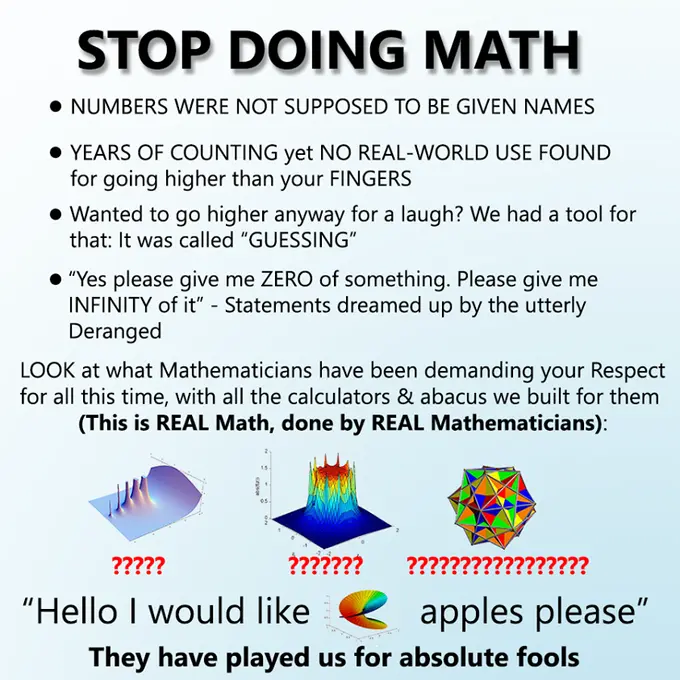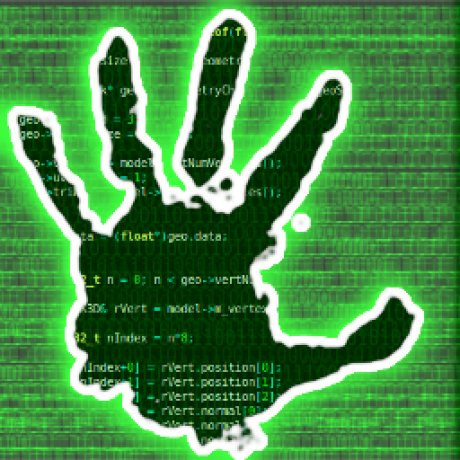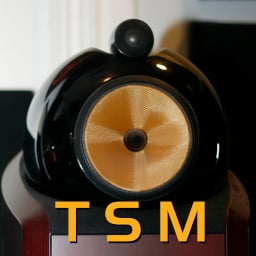Serious answer: Posits seem cool, like they do most of what floats do, but better (in a given amount of space). I think supporting them in hardware would be awesome, but of course there’s a chicken and egg problem there with supporting them in programming languages.
Posits aside, that page had one of the best, clearest explanations of how floating point works that I’ve ever read. The authors of my college textbooks could have learned a thing or two about clarity from this writer.
Based and precision pilled.
As a programmer who grew up without a FPU (Archimedes/Acorn), I have never liked float. But I thought this war had been lost a long time ago. Floats are everywhere. I’ve not done graphics for a bit, but I never saw a graphics card that took any form of fixed point. All geometry you load in is in floats. The shaders all work in floats.
Briefly ARM MCU work was non-float, but loads of those have float support now.
I mean you can tell good low level programmers because of how they feel about floats. But the battle does seam lost. There is lots of bit of technology that has taken turns I don’t like. Sometimes the market/bazaar has spoken and it’s wrong, but you still have to grudgingly go with it or everything is too difficult.
all work in floats
We even have
float16 / float8now for low-accuracy hi-throughput work.Even float4. You get +/- 0, 0.5, 1, 1.5, 2, 3, Inf, and two values for NaN.
Come to think of it, the idea of -NaN tickles me a bit. “It’s not a number, but it’s a negative not a number”.
I think you got that wrong, you got +Inf, -Inf and two NaNs, but they’re both just NaN. As you wrote signed NaN makes no sense, though technically speaking they still have a sign bit.
Right, there’s no -NaN. There are two different values of NaN. Which is why I tried to separate that clause, but maybe it wasn’t clear enough.
But if you throw an FPU in water, does it not sink?
It’s all lies.
I’d have to boulder check, but I think old handheld consoles like the Gameboy or the DS use fixed-point.
Floats make a lot of math way simpler, especially for audio, but then you run into the occasional NaN error.
On the PS3 cell processor vector units, any NaN meant zero. Makes life easier if there is errors in the data.
I have been thinking that maybe modern programming languages should move away from supporting IEEE 754 all within one data type.
Like, we’ve figured out that having a
nullvalue for everything always is a terrible idea. Instead, we’ve started encoding potential absence into our type system withOptionorResulttypes, which also encourages dealing with such absence at the edges of our program, where it should be done.Well,
NaNisnullall over again. Instead, we could make the division operator an associated function which returns aResult<f64>and disallowf64from ever beingNaN.My main concern is interop with the outside world. So, I guess, there would still need to be a IEEE 754 compliant data type. But we could call it
ieee_754_f64to really get on the nerves of anyone wanting to use it when it’s not strictly necessary.Well, and my secondary concern, which is that AI models would still want to just calculate with tons of floats, without error-handling at every intermediate step, even if it sometimes means that the end result is a shitty vector of
NaNs, that would be supported with that, too.I agree with moving away from
floats but I have a far simpler proposal… just use a struct of two integers - a value and an offset. If you want to make it an IEEE standard where the offset is a four bit signed value and the value is just a 28 or 60 bit regular old integer then sure - but I can count the number of times I used floats on one hand and I can count the number of times I wouldn’t have been better off just using two integers on -0 hands.Floats specifically solve the issue of how to store a ln absurdly large range of values in an extremely modest amount of space - that’s not a problem we need to generalize a solution for. In most cases having values up to the million magnitude with three decimals of precision is good enough. Generally speaking when you do float arithmetic your numbers will be with an order of magnitude or two… most people aren’t adding the length of the universe in seconds to the width of an atom in meters… and if they are floats don’t work anyways.
I think the concept of having a fractionally defined value with a magnitude offset was just deeply flawed from the get-go - we need some way to deal with decimal values on computers but expressing those values as fractions is needlessly imprecise.
Nan isn’t like null at all. It doesn’t mean there isn’t anything. It means the result of the operation is not a number that can be represented.
The only option is that operations that would result in nan are errors. Which doesn’t seem like a great solution.
Well, that is what I meant. That
NaNis effectively an error state. It’s only likenullin that any float can be in this error state, because you can’t rule out this error state via the type system.Why do you feel like it’s not a great solution to make
NaNan explicit error?Theres plenty of cases where I would like to do some large calculation that can potentially give a NaN at many intermediate steps. I prefer to check for the NaN at the end of the calculation, rather than have a bunch of checks in every intermediate step.
How I handle the failed calculation is rarely dependent on which intermediate step gave a NaN.
This feels like people want to take away a tool that makes development in the engineering world a whole lot easier because “null bad”, or because they can’t see the use of multiplying 1e27 with 1e-30.
It doesn’t have to “error” if the result case is offered and handled.
Float processing is at the hardware level. It needs a way to signal when an unrepresented value would be returned.
My thinking is that a call to the safe division method would check after the division, whether the result is a
NaN. And if it is, then it returns an Error-value, which you can handle.Obviously, you could do the same with a
NaNby just throwing an if-else after any division statement, but I would like to enforce it in the type system that this check is done.I feel like that’s adding overhead to every operation to catch the few operations that could result in a nan.
But I guess you could provide alternative safe versions of float operations to account for this. Which may be what you meant thinking about it lol
While I get your proposal, I’d think this would make dealing with float hell. Do you really want to
.unwrap()every time you deal with it? Surely not.One thing that would be great, is that the
/operator could work betweenResultandf64, as well as betweenResultandResult. Would be like doing a.map(|left| left / right)operation.Well, not every time. Only if I do a division or get an
ieee_754_f64from the outside world. That doesn’t happen terribly often in the applications I’ve worked on.And if it does go wrong, I do want it to explode right then and there. Worst case would be, if it writes random
NaNs into some database and no one knows where they came from.As for your suggestion with the slash accepting
Results, yeah, that could resolve some pain, but I’ve rarely seen multiple divisions being necessary back-to-back and I don’t want people passing around aResult<f64>in the codebase. Then you can’t see where it went wrong anymore either.
So, personally, I wouldn’t put that division operator into the stdlib, but having it available as a library, if someone needs it, would be cool, yeah.
Floats are only great if you deal with numbers that have no needs for precision and accuracy. Want to calculate the F cost of an a* node? Floats are good enough.
But every time I need to get any kind of accuracy, I go straight for actual decimal numbers. Unless you are in extreme scenarios, you can afford the extra 64 to 256 bits in your memory
No real use you say? How would they engineer boats without floats?
Just invert a sink.
Float is bloat!
Call me when you found a way to encode transcendental numbers.
Perhaps you can encode them as computation (i.e. a function of arbitrary precision)
Hard to do as those functions are often limits and need infinite function applications. I’m telling you, math.PI is a finite lie!
Do we even have a good way of encoding them in real life without computers?
Just think about them real hard
\pi
May I propose a dedicated circuit (analog because you can only ever approximate their value) that stores and returns transcendental/irrational numbers exclusively? We can just assume they’re going to be whatever value we need whenever we need them.
Wouldn’t noise in the circuit mean it’d only be reliable to certain level of precision, anyway?
I mean, every irrational number used in computation is reliable to a certain level of precision. Just because the current (heh) methods aren’t precise enough doesn’t mean they’ll never be.
You can always increase the precision of a computation, analog signals are limited by quantum physics.
Precision piled.
Obviously floating point is of huge benefit for many audio dsp calculations, from my observations (non-programmer, just long time DAW user, from back in the day when fixed point with relatively low accumulators was often what we had to work with, versus now when 64bit floating point for processing happens more as the rule) - e.g. fixed point equalizers can potentially lead to dc offset in the results. I don’t think peeps would be getting as close to modeling non-linear behavior of analog processors with just fixed point math either.
Audio, like a lot of physical systems, involve logarithmic scales, which is where floating-point shines. Problem is, all the other physical systems, which are not logarithmic, only get to eat the scraps left over by IEEE 754. Floating point is a scam!
The meme is right for once
The only reason for floating point numbers is to use your laptop as a life buoy
From time to time I see this pattern in memes, but what is the original meme / situation?
It’s my favourite format. I think the original was ‘stop doing math’

deleted by creator
That doesn’t really answer the question, which is about the origins of the meme templete
Yikes. placed this in the wrong spot. Thank you.
I’m like, it’s that code on the right what I think it is? And it is! I’m so happy now
Uhm, I haven’t programmed in a low level language in years. I use python for my job now, and all I know are floats and ints. I don’t know what this foreign language is you speak of.












